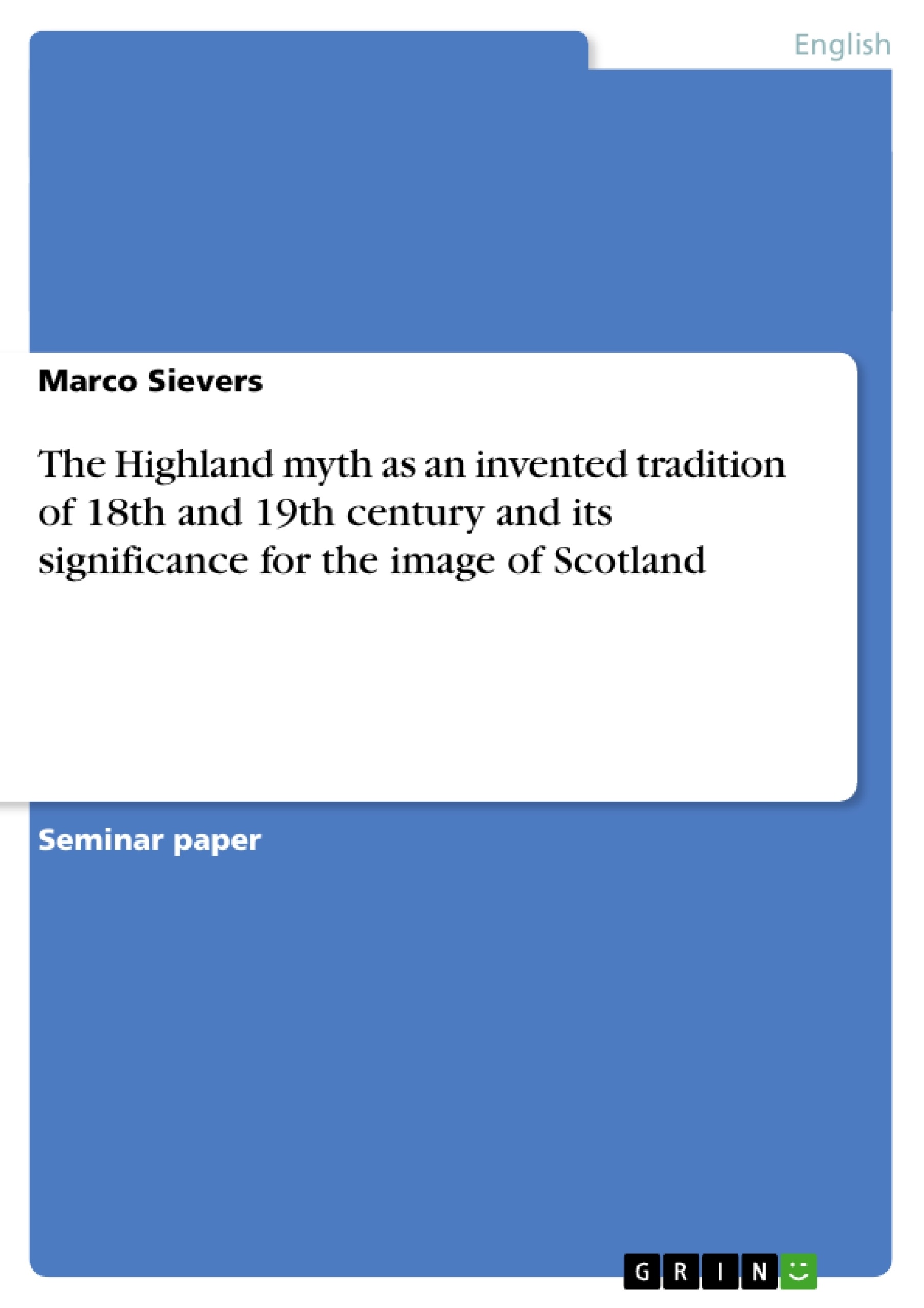If people around the globe are asked what they associate with Scotland or the Scots, tartan kilts, bagpipes, clans and the Highlands are the most common answers. Especially tourist interest concentrates on these landmarks of Scotland, which are said to be insignias of Scottish tradition, glory and identity, and which dominate the image of Scotland.
But are these landmarks really linked to a tradition from times immemorial? Do they really represent a link to Scotland’s Gaelic roots? This paper will investigate this question by introducing Eric Hobsbawm´s term of “invented tradition” to denote and to outline the process of creation of these Scottish symbols. The following portrait of the historical background will show the social, political and economic developments in the 18th and 19th century which led to the invention of tradition as part of the creation of a Highland myth as a result of and as reaction to Scotland’s union with England in 1707. Furthermore, the worldwide spreading of the Highland myth, which has determined the image of whole Scotland ever since, will be described. The paper will finish by showing contemporary parallels to the historic developments and trends, and suggesting further topics of investigation.
Table of Contents
- Introduction
- Main Part
- Invented Tradition – An Outline of the Creation of the Highland Myth
- A Break in Continuity – The Destruction of the original Highland Culture in the 18th century
- The Rediscovery of the Highlands and the Creation of the Highland Myth
- James McPherson's Ossian (1760)
- The Historic Novels of Sir Walter Scott
- The Invention of Traditions - The Highland Bagpipes and the Tartan Philibeg
- The Scottish Highland Bagpipes
- The Tartan Philibeg
- The Kilt
- Differentiation of Tartan Patterns by Clans
- The Spreading of the Myth
- Conclusion and Further Worthwhile Topics of Investigation
Objectives and Key Themes
This paper investigates the creation of iconic Scottish symbols such as the tartan kilt, bagpipes, clans, and the Highlands, using Eric Hobsbawm's concept of "invented tradition". It examines how these symbols came to be associated with Scottish identity and tradition, despite their relatively recent origins, and how they reflect social, political, and economic developments in the 18th and 19th centuries. The paper analyzes the process of "invention" by exploring the historical context, the role of key figures such as James McPherson and Sir Walter Scott, and the subsequent dissemination of the Highland myth.
- The concept of "invented tradition" and its application to the Highland myth
- The historical context of the creation of the Highland myth
- The role of key figures in shaping the Highland myth
- The impact of the Highland myth on the image of Scotland
- Contemporary parallels and future directions for research
Chapter Summaries
- Introduction: This chapter introduces the topic of the Highland myth and its significance for the image of Scotland. It poses the question of whether these symbols are truly rooted in Scottish tradition or are a more recent invention. The paper will use Eric Hobsbawm's concept of "invented tradition" to explore the process of creation and dissemination of these symbols.
- Invented Tradition – An Outline of the Creation of the Highland Myth: This chapter outlines the concept of "invented tradition" as defined by Eric Hobsbawm. It explains how invented traditions emerge as a response to social change and seek to establish continuity with a past that is often constructed or adapted. The chapter sets the stage for analyzing the creation of the Highland myth within the context of social and political transformations in 18th and 19th century Scotland.
- A Break in Continuity – The Destruction of the original Highland Culture in the 18th century: This chapter examines the historical background of the Highlands, highlighting the cultural and political differences between the Highlands and Lowlands. It describes the gradual destruction of the original Highland culture in the 18th century, setting the stage for the subsequent rediscovery and reinvention of Highland traditions.
- The Rediscovery of the Highlands and the Creation of the Highland Myth: This chapter explores the rediscovery of the Highlands and the creation of the Highland myth in the 18th and 19th centuries. It analyzes the role of key figures such as James McPherson and Sir Walter Scott, whose works romanticized the Highlands and contributed to the formation of a specific image of Scottish identity.
- The Invention of Traditions - The Highland Bagpipes and the Tartan Philibeg: This chapter delves into the specific creation of the Highland bagpipes and the tartan kilt as symbols of Scottish identity. It examines how these objects, which were not traditionally worn in the Highlands, became associated with Scottish culture and tradition through a process of symbolic and ritualistic invention.
- The Spreading of the Myth: This chapter examines the dissemination of the Highland myth beyond Scotland, tracing its influence on the wider perception of Scottish culture and identity. It discusses how the myth was reinforced and spread through tourism, literature, and popular culture.
Keywords
This paper focuses on the Highland myth, invented traditions, Scotland, identity, 18th and 19th centuries, cultural history, cultural identity, Eric Hobsbawm, James McPherson, Sir Walter Scott, tartan, bagpipes, kilt, clans, tourism, literature, popular culture.
- Quote paper
- Dipl.Jurist Marco Sievers (Author), 2005, The Highland myth as an invented tradition of 18th and 19th century and its significance for the image of Scotland, Munich, GRIN Verlag, https://www.grin.com/document/75988




